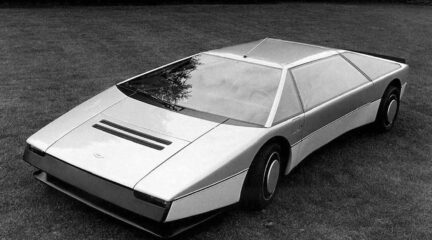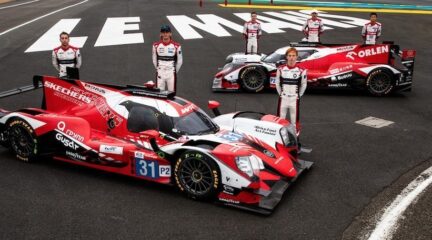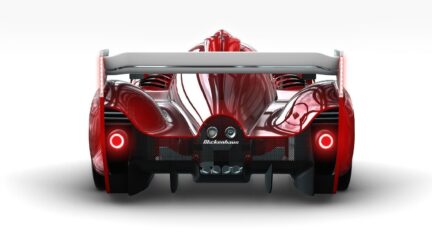
Het is dit jaar exact 50 jaar geleden dat Aston Martin met de DBR1 de 24 uur van Le Mans op zijn naam wist te schrijven. Dit was tevens de laatste overall overwinning van Aston Martin tot nu toe, maar ze zijn vastbesloten om dit jaar met de Lola-Aston Martin LMP1 dit kunststukje te herhalen.
Of het ze gaat lukken om de diesels van Audi en Peugeot te verslaan durf ik niet te zeggen (ik vrees van niet). Maar we kunnen nog wel even genieten van de race die ze 50 jaar geleden wel wisten te winnen. Aston Martin heeft namelijk een documentaire van bijna 30 minuten over deze race ter beschikking gesteld. En dat is (zeker voor fans) heel erg leuk om naar te kijken!
Prachtig om te zien hoe de raceauto’s toen nog gewoon over de openbare weg van het dorp naar het circuit reden. En de coureurs zonder gordels of wat dan ook in de auto springen. Ook werd die 24 uur durende race door slechts 2 coureurs gereden! Je valt van de ene verbazing in de andere.
Aston Martin verscheen in 1959 met 3 DBR1’s aan de start en achter het stuur zaten onder andere Stirling Moss en Caroll Shelby. De grootste concurrent was Ferrari die met de Ferrari 250 Testa Rossa 59 aan de start kwamen. Het was een ware slijtageslag want uiteindelijk kwamen slechts 12 van de 53 auto’s aan de finish.
Bekijk de video’s hieronder:
En lees hieronder het verhaal van Caroll Shelby over Le Mans 1959
Carroll Shelby looks back at 1959 Le Mans win
Gaydon, 5 June 2009. Fifty years ago, American racing legend Carroll Shelby formed one half of the Le Mans-winning Aston Martin DBR1 team, together with Englishman Roy Salvadori. In his own words, Shelby describes the historic experience that he defines as the highlight of his racing career.
“It was an amazing time with Aston Martin, which I will always have a huge amount of affection for. In particular, I’ve got so many memories of 1959 and they’re actually all very different memories. We went through gallons of oil, for example. At the end of the race [Aston Martin’s then owner] David Brown got in the car for the victory lap. It meant so much to him; I guess he had wanted to win Le Mans all of his life. When he knew we were going to win, he’d dressed up in all of his finery with a new sports coat and everything. But after he got into the car at the end, he sat in about an inch of oil! I felt quite sorry for him, all dressed up like that and covered in oil! But I guess that under the circumstances he didn’t mind too much…
Back then, our racing budget was £150,000 for the whole season. A bit like the case back then, Aston Martin today has managed to achieve a lot with limited resources. I still have a lot of respect for the team and I’ll be thinking of everyone there at Le Mans.
It’s all so different though. These days I guess I would hardly recognise the place. Now Le Mans is more like a 24-hour sprint. Back then it was very different; everything was a series of compromises. There was no automatic rev limiter – only our feet – and the gearbox and clutch were not very strong. It was much more about endurance then. One slip and you could blow the engine.
But actually it’s impossible to compare 1959 and 2009. I always break racing down into eras, and you can’t say that one era was any easier or more difficult than the next era or the one before. It’s like comparing apples to oranges. The feeling of winning though: I’m sure that’s not changed much!
Physically it was very tough as I had dysentery during the entire race in 1959; something I ate I think! That was one of my main problems, but at Le Mans you just rise above any discomfort and forget everything else. That’s because when you have a chance to win Le Mans it’s the chance of a lifetime. Looking back on it though, it must have been really tricky as I didn’t eat anything for 24 hours apart from dysentery tablets. Then we won the race and – oh my God – they suddenly stuck a champagne bottle in my mouth and it sent me a bit loopy! I was so tired I could hardly stand or think. I reckon I just collapsed afterwards and slept for about 12 hours.
Times change but I’m sure I would have enjoyed driving the modern LMP1 car too. Racing drivers just adapt to whatever machinery they have and learn as they go along. That’s always been the case and always will be. We didn’t do that much practice before the 1959 race, for example, as we didn’t need it. We already knew the circuit and besides, you’ve got a whole 24 hours to answer any other questions you might have. Our priority was getting through the race and not making any mistakes. Believe me, there was plenty of potential to get it very badly wrong. Or for someone to get it wrong for you.
Back then, it probably rained at every race in Le Mans. Then you had the fog at night and the slow cars doing around 80mph on the right hand side of the truck – that was the rule – and we were doing 160mph to 165mph on the left. You just had to hope it all worked out. And in 1959, it certainly did.
One thing that’s still the same between then and now is the fact that Le Mans is so very different to anywhere else. The 24 Hours is legendary because it presents a whole new and different set of problems compared to other races. I’m sure that’s still true now.
My personal message to the Aston Martin drivers before they start the race next weekend would simply be – carry the flag. Roy Salvadori and I are both really proud of you. Let’s hope that this wonderful team goes on for another 50 years and the very best of luck to you all.”
Aston Martin would like to thank Carroll Shelby for his kind participation in this interview.
Aston Martin goes back to the future 1959 – 2009
Gaydon, 4 June 2009. The 77th Le Mans 24 Hours marks a milestone in the history of Aston Martin as the iconic sports car manufacturer celebrates the 50th anniversary of its first win at Le Mans.
As will be the case in 2009, Aston Martin entered three factory cars in the 1959 race: for Stirling Moss/Jack Fairman, Roy Salvadori/Carroll Shelby and Paul Frère /Maurice Trintignant.
At the time Ferrari was the dominant force in endurance racing, so the Aston Martin team entered the race as underdogs and had to come up with a clever race strategy to defeat the Italian squad. It was decided that the Moss/Fairman car would act as a ‘hare’ to try and force the Ferrari team into an unsustainably quick pace, while the other Aston Martins would follow.
The tactic worked brilliantly, and at 4pm on Sunday 21 June 1959 the Salvadori/Shelby DBR1 crossed the finish line at Le Mans ahead of the sister car of Frère/Trintignant after 24 hours and 4347.9 kilometres of racing. The closest Ferrari, a privateer example in third, was a full 25 laps down.
While the race was a resounding success for Aston Martin and the DBR1, not everything went entirely to plan 50 years ago, as Salvadori remembered. “At the start we quickly got into the hunt and took the lead in the late evening,” he said. “Then we ran into a severe vibration problem. I made a pit stop but the trouble could not be diagnosed so I was sent off again to complete my stint. This cost us a lot of time and we had to make two more pit stops before the fault was found: a large chunk of tread had come off a rear tyre but due to the dark and the aerodynamic spats over the rear wheels this could not be seen.”
The number 5 Aston Martin DBR1 pitted in the night to have the offending tyre changed, and then it started gaining on the lead Ferrari. “We were faster than the Ferrari and catching it all the time,” added Salvadori. “When the Ferrari retired on Sunday morning, I received a ‘slow’ signal from the pits. But I slowed so much that I had to be speeded up again, as Paul Frère and Maurice Trintignant in the other DBR1 were catching us up!”
A one-two at Le Mans was just one of the high points of a tremendous season for Aston Martin, in which the company also won the World Sportscar Championship.
Aston Martin returns to the top class at Le Mans 50 years later as the underdog once more, but the team is hoping to take the fight to the mighty diesel-powered opposition. These days, there are three drivers to every car as opposed to two in the DBR1’s day, but according to Salvadori a strong working relationship between team mates is still an essential ingredient to success.
“Carroll and I were the ideal partnership,” he said. “We were chosen together because we were the same height and we could both put our left foot between the brake and clutch pedals. We were comfortable together and the team thought that it was a good partnership. At Le Mans back in 1959 we only did one day of practice, or seven laps each.”
The Aston Martin Racing team is preparing for Le Mans this year through participation in the Le Mans Series, which has so far resulted in a win at Barcelona and a podium in Spa. With no Le Mans test day this year, all the teams will have limited running at La Sarthe before embarking on the endurance classic on June 13 at 3pm local time.
Last year’s pole time at Le Mans was 3m18.513; in 1959 the winning DBR1 was set a target lap time of around 4m20s, whereas the fastest lap (set by Moss) was 4m01s. According to the team’s strategy, the Salvadori/Shelby crew concentrated on reliability by keeping their car relatively unstressed and adopting a conservative rev limit.
By the very end of the 1959 race, with a huge margin over the third-placed competitor, the leading Aston Martins could afford to lap at around 4m50s. By contrast, Le Mans these days is more like a series of sprint races punctuated by pit stops – with the race laps not hugely dissimilar to the qualifying laps.
Shelby said: “The DBR1 was a very good handling car but slower down the straight. However, we were definitely superior to the others in terms of handling. And you always felt safe in the car – you always wanted to drive the Aston. I never heard a driver criticise it. At the end, I couldn’t believe we’d won Le Mans because we’d dreamed of it for so long. To win at Le Mans at last was the epitome. Aston Martin was like a personal family and I was very happy for the team.”
The odds are stacked against Aston Martin this year, just as they were in 1959 but Le Mans is a race where miracles can still happen. Just as was the case 50 years ago, winning the Le Mans 24 Hours is not simply a question of having the quickest car or the best-funded team – and that is one of the very few things that has never changed at the Circuit de La Sarthe.
The Aston Martin Racing team is now completing its final preparations for the epic race, hoping for the smallest chance that history might repeat itself. Whatever the outcome, just getting to the end of what is arguably the world’s toughest race is a human and mechanical triumph in itself.











Schitterende tijden, die 50er jaren.
Autoblog, een leuke tip trouwens: http://www.autoblog.com/2009/06/09/whats-in-a-name-lotus-to-return-to-formula-one/
hij gaat harder dan ik zou verwachte :S in die 50 jaar
-edit: check!-
Echt leuk om de historie van het merk te bekijken. DBR1 is nog steeds een icoon binnen Aston Martin. Hopelijk maakt LMP1 korte metten met Audi en Peugeot, maar mijn gevoel zegt dat Audi weer gaat winnen.
Aston Martin is en BLIJFT stoer(hopelijk dan!)
Ik denk en hoop dat Peugeot Audi eindelijk eens van de troon stoot. Ze hebben het Audi vorig jaar al aardig moeilijk gemaakt en ik gun het Peugeot gewoon.
Jammer dat de Le Mans Astons er niet zo uit kunnen zien als de weg-astons i.v.m. stroomlijn.:P
Prachtig!
Echt geweldig die jaren 50 race auto’s :)
Ik hoop dat de Lola-Aston Martin LMP1 auto die diesels van Peugot en Audi een lesje leert! (hopelijk heeft onze Jos The Boss ook succes is z’n Aston) ;)
Toen leken de raceauto’s tenminste nog op auto’s…
Geweldig. Ik heb een tijdje terug een (heerlijk oud) boek van Paul Frère over Le Mans gelezen. Verbazingwekkend hoe de races zich daar -net als op andere beroemde circuits- van straatraces tot circuitraces hebben ontwikkeld. Ook leuk om te lezen zijn de soms bizarre reglementen.
Er was overigens ook een tijd dat Amerikaanse auto’s overwinningen boekten.
De filmpjes ga ik vanavond even lekker in alle rust bekijken!
Schitterend filmpje!
Toen racen nog om het racen ging, en niet om het hele commerciële circus eromheen…
Daarom kijk ik ook graag naar oude F1 beelden, of Group A rally: allemaal hetzelfde verhaal tegenwoordig: gevangen in allerlei netten van commercie tot en met veiligheid…
Gaaf om te zien hoe het er toen aan toe ging en hoe hard ze toen ook al reden en ja met 2 coureurs top hoor. Helaas dit jaar geen overwinning voor Aston maar wie weet volgend jaar.
-edit: linkjes spammen doe je maar ergens anders-